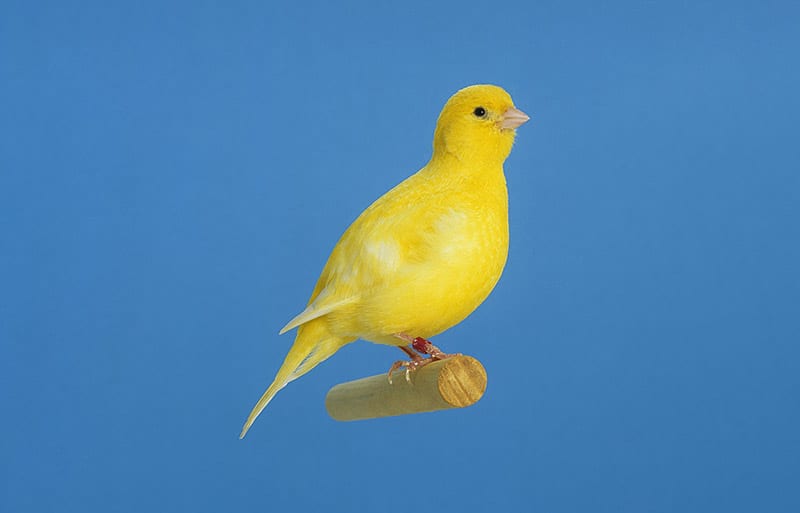Despite its small size, the Fife Fancy Canary is very lively and a great choice for the beginner. This delightful little bird is quite hardy and very easy to keep.They are not prone to disease, come in all the canary colors, and the male has a wonderful pleasant song. They are also ready breeders and most often good at rearing their young.
The Fife Fancy Canary is a “type canary”, bred for physical characteristics rather than color or song. They are a newer canary variety, developed in the 1950’s by Scottish breeders in and around the area of Fife. It is a smaller version of the Border Canary. With the emphasis on developing the Border into a larger bird, dedicated Scots devoted their efforts to bringing back the original standard of the Border. Thus the Fife Fancy Canary came into being, capturing the hearts of people around the world.
- For more information about the care of Canaries see: Guide to a Happy, Healthy Canary
Scientific Classification
| Kingdom: | Animalia |
| Phylum: | Actiniform |
| Class: | Elasmobranchii |
| Order: | Passeriformes |
| Family: | Fringillidae |
| Genus: | Serinus |
| Species: | canaria |
Scientific Name
Distribution
Being one of the more recently developed “type” canaries, the Fife Fancy Canary has a well l documented history. It was developed in the 1950’s in and around the county of Fife in Scotland. It is a smaller version of todays Border Canary, which has been developed into a larger bird reaching about 5 1/2 inches (14 cm). The development of the Fife was the result of efforts to bring back the Borders original smaller standard, a bird whose length is 4 1/2 inches (11.4 cm). In 1957 a meeting in Kircaldy, Scotland was called and a new society was formed specializing in this smaller bird. The Fife Fancy Canary was officially accepted and is enthusiatically supported.
Description
Many fanciers regard the Fife Fancy Canary as a miniature of the Border Canary. Indeed, except for its size, which must not exceed 4 1/4 inches, that means about 11 cm, the two breeds are extremely similar. The grand essentials of a Fife Fancy Canary are controlled roundness, combined with type, quality and natural color in a diminutive form.
These birds are available in a wide variety of colors including white, yellow, buff, blue, cinnamon, green, and many variegations of these colors
Care and feeding
Canaries like wide open spaces so provide a roomy cage. Provide a cage with vertical bars and small perches of different size for foot exercise. Have at least 1 perch set high in the cage for the canary to roost (sleep). The cage should be placed high, so the canary can look down on us so to speak.
Canaries eat mainly canary seed and rape seed. Vitamin coated canary seed mixes are readily available at a pet store. Greens are also enjoyed and can be offered daily along with a little calcium in the form of a cuttlebone.
They do like to bath, so should be offered a bird bath. Cage cleaning and toe nail trimming is about all the maintenance canaries need.
- See About Canaries: Housing and About Canaries: Care and Feeding for more information.
Social Behaviors
They are good-natured social creatures that do well when kept in cages or in aviaries. They are timid birds though and should not be housed with parakeets, lovebirds, or other hookbills that tend to be more aggressive birds by nature.
Male canaries should be kept in a cage by themselves to ensure quality singing. Males can be territorial and pairing up with two male canaries in a cage can cause fights. In a spacious aviary canaries can generally be housed with other canaries, finches, and other hardbills.
Activities
Canaries do not require toys, mirrors or any other form of entertainment, a swing is all they need to keep themselves occupied. Most of the time, canaries are simply enjoyed for their beauty and singing. However, some canaries are allowed out of their cage to perch or are show canaries and therefore require taming or training.
- See About Canaries: Handling/Training for information on taming and training.
Breeding/Reproduction
The Fife Fancy Canary is a ready breeder making it a good choice for a beginner. Most canaries breed easily and readily if provided with quality food, lighting, secure surroundings, and conditioning. Breeding season for most canaries is usually from December to April. They are best bred in breeding cages.They lay their eggs in a nest. The female will lay 3 to 6 eggs, one per day. It is best to allow a hen to have only two clutches. The Fife Fancy Canary is generally good at rearing its young.
See About Canaries: Breeding/Reproduction for more information on breeding.
Potential Problems
These birds are hardy and healthy if provided with a good environment and a good diet. Avoid an environment that is wet, cool, and drafty.
See About Canaries: Potential Problems for information on health.
Availability
Fife Fancy Canaries are fairly available and inexpensive, similar to the Border Canary with prices ranging about $50 to $150 US. Sometimes available at pet stores, but more readily they can be found through bird shows, bird clubs, breeders, and on the internet.
Featured Image Credit: Tony Tilford, Shutterstock
